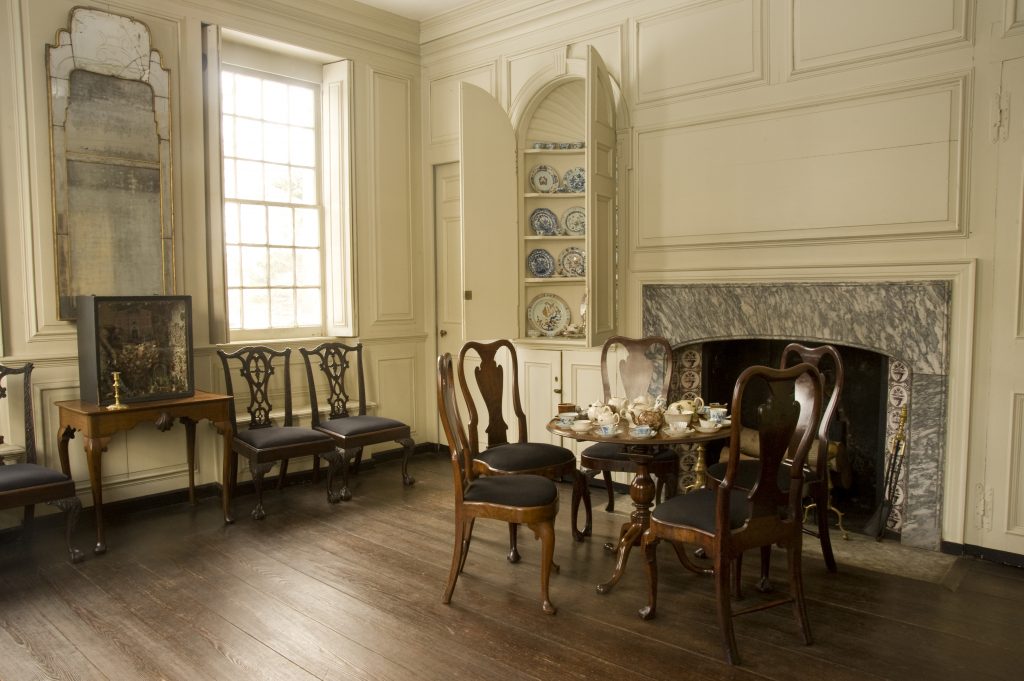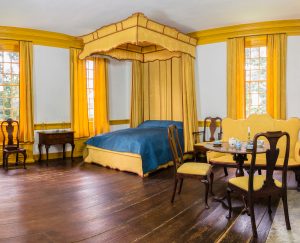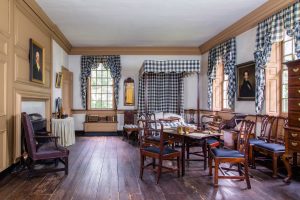‘Adapting to Survive’ and Thrive: Interpreting Eighteenth-Century Reality in the Twenty First-Century Virtual Realm

Stenton Parlor, photo by Laura Pearson. Courtesy of The National Society of The Colonial Dames of America in the Commonwealth of Pennsylvania at STENTON
Like museums around the world, historic houses are dealing with the new challenges posed by Covid-19. On Thursday, Nov. 19 at 1:00pm EST, the American Friends of Attingham will host an online lecture by Ben Cowell titled “Adapting to Survive,” addressing how the pandemic has affected the country house sector in the United Kingdom. UPDATE: For a short time, a recording of the lecture will be available at a link on the American Friends of Attingham website.
In this spirit, today we are featuring a post by Laura Keim, an Attingham Summer School alumna and Curator at Stenton, an eighteenth-century house in Philadelphia, discussing how Stenton has worked to bring the house to new audiences over the past 9 months.–ANR
The COVID-19 pandemic of 2020-2021 has forced institutions of all kinds to shut down, shift focus, and learn to operate in new ways and in new arenas — a true test of resilience in the face of uncertainty and the looming threat of illness, death, job losses, and economic hardship. Co-vid in Latin literally means “seeing together;” pan-demic in Greek literally means “all people.” A silver lining in the pandemic is that museums, including historic house museums, which tend to be smaller operations, have pivoted programming to the online realm, where theoretically “all people” with a device and an internet connection can “see together” and connect to places and collections, near and far, that they might not otherwise visit in person.
Historic houses are place-based museums, grounded in their locale, physical remnants of a past time, with which people seek to connect. Whereas art museums feature great and important objects, historic house museums are interpreted repositories of domestic life. The totality of the context is the curated collection and audience experience. Visitors frequently want to know if objects or features are “original” or “real.” They seek a sense of visceral and intimate connection to the place and its former inhabitants that comes from immersing oneself in the spaces. Although virtual reality technology and 3-D scanning have begun to offer digital immersive environments, that technology is not yet an industry standard.

Yellow Lodging Room, photo by Jere Paolini. Courtesy of The National Society of The Colonial Dames of America in the Commonwealth of Pennsylvania at STENTON
At Stenton, a c.1730 brick gentleman’s house in Philadelphia built for Colonial Statesman James Logan, we started driving content online in March, just after the shutdown. A museum operated by The National Society of The Colonial Dames of America in the Commonwealth of Pennsylvania since 1899, Stenton moved, relatively seamlessly, into digital audience engagement, a testimony to the steady leadership from our Executive Director and the Dames. We began with social media, creating a “Curator’s Cabinet of Curiosities” series of Facebook posts to build online content highlighting some of Stenton’s less-seen collections, creating new connections between objects at Stenton and in collections outside the museum. These posts then went out to our email list as a weekly blog.
The programs team repackaged some of the History Hunters Youth Reporter materials and activities for online consumption for parents and teachers muddling through virtual school from home. History Hunters is a literacy-based, field-trip program that usually offers approximately 3,500 fourth and fifth grade Philadelphia public schoolchildren subsidized trips to five historic sites for a comprehensive, year-long social studies curriculum. The Director of Education repositioned the History Hunters website as a resource for teachers and parents, who suddenly were teaching their children at home. Over the summer, the History Hunters program underwent its biggest transformation in its seventeen year history to a fully virtual field trip program, as Philadelphia schools will remain online into the 2020-21 school year.
Stenton’s Executive Director rapidly transformed Stenton’s annual Garden Party into a successful virtual event, which raised funds to support our burgeoning virtual programming. We began dabbling in Facebook Live tours in June, expanding to illustrated Zoom talks over the summer. All the recorded real-time tours and talks are available as YouTube videos, which are now available on our website. Learning as we went along, we took risks with unfamiliar technology and formats in real time, with a supportive audience of devoted online followers.

Blue Lodging Room, photo by Jere Paolini. Courtesy of The National Society of The Colonial Dames of America in the Commonwealth of Pennsylvania at STENTON
In addition, the pandemic offered an opportunity to create and record tours of individual rooms, such as Stenton’s Parlor and the Blue Lodging Room, as well as spaces visitors seldom visit, or in new sequences, based on themes such as a “Back-to-front and Upstairs-Downstairs” tour, and a “Food Axis Tour,” a concept drawn from Elizabeth C. Cromley’s book, The Food Axis: Cooking, Eating and the Architecture of American Houses (2011). We have playfully used events as opportunities to create short Facebook LIVE programs. When preparing to open the grounds to the public, we offered a conversational garden tour with our horticulturalist, and when the Philadelphia Museum of Art decided to withdraw loan of a chair, we created a LIVE look at features of “Logan and Loganesque Queen Anne chairs.”
These efforts have also enabled us to continue the important work of connecting with the communities that immediately surround Stenton in 2020. In recent years, Stenton’s staff has deepened relationships with our predominantly African-American local community as part of a project to re-memorialize Dinah, an enslaved woman who lived and labored at Stenton from the mid-eighteenth century until her death in 1805, and who saved the house from burning by the British in 1777. Through research into the Logan papers at the Historical Society of Pennsylvania and in the Quaker collection at Haverford College, we have deepened understanding of Dinah as a person as well as a heroine, someone more than the “Faithful Colored Caretaker of Stenton” as she was described on a memorial plaque in 1912. A Zoom webinar presented new research on enslaved and indentured labor at Stenton. A true drawback of the pandemic is the loss of personal connection we feel with our community. Online programs do not replace being present in person, learning together, sharing meals, exchanging ideas, and being able to embrace. When we can again, that will be a glorious day!
Launching Stenton programs online involved risk-taking, trial-and-error, and learning the limits of wi-fi through the thick walls of an eighteenth-century house. At least one clip-on wireless microphone and wi-fi extenders are key tools for this work. The pandemic presented the opportunity to use our existing technology, smartphones and laptops, to present content in alternative ways that have been available but untested for some time. In-person presentations and programs have a one-time life; whereas these recorded programs can be appreciated by a diverse and geographically-dispersed audience over a period of months or years. Even as the world shifts to an altered “normal,” this virtual content will live on and continue to grow, not just because it has become expected of museums, but because it enhances the way our audiences can experience the house museum from anywhere, any time. The virtual historic house museum indeed transcends the bounds of time and space when its content is available on the web.
In addition, the pandemic has motivated us to consider updating our collections database for online availability, asking questions about how to build its capacity as an interpretive tool. Online exhibits are another venue we look to explore. Learning to archive and maintain the digital life of our institution as the files accumulate will be a future challenge. The very reason for the museum is grounded in its physical, material reality as an immovable building and as a place for gathering visitors, building audiences, and fostering community. With each event and partnership, we are proving that we can produce content and generate connection in the online world. The true nature of historic places is that we cannot go back in time. Historic house curators assemble objects and research context to present a picture of the past based on physical and documentary evidence, yet the physical and online domains of historic house museums still represent an imagined experience of space, an evolving and moving target as we continually adjust our vision to changing circumstances and the possibilities they present.